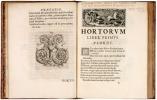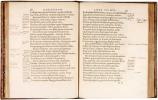Hortorum libri IV. Cum disputatione de cultura hortensi.
Eur 7,500 / USD 8,600
The price shown on each item does not include V.A.T (Value Added Tax). As a result of the recent EU legislation we are required to charge our EU customers the percentage of V.A.T. charged by the customer’s country of residence, unless they possess a V.A.T. registration number. Postage Additional.
Paris, Typographia Regia, 1665. 4to (255 x 198 mm). pp. (xxvi including frontispiece), 219 with engraved frontispiece, engraved vignette with royal arms on title, nine engraved head- and tailpieces, and six engraved initials. Contemporary red morocco, spine in 6 compartments with gilt ornaments and lettering, sides with gilt coat of arms of Louis XIV and gilt border lines, inside dentelles, gilt edges.
first edition of Rapin's celebrated poem on gardens, and a fine piece of book design
A superbly bound copy of the first edition of Rapin's celebrated poem on gardens, and a fine piece of book design. René Rapin (1621-1687), a Jesuit, wrote this work in imitation of Virgil's 'Georgics'. It is divided into four books, on the flower garden, parkland and trees, water, and the orchard. It is followed by a work in prose, a debate between the 'ancients' and 'moderns' on gardening styles, in which Rapin endorses the 'modern' style. This work enjoyed immense renown, and was translated into English by John Evelyn.
"On the threshold of this period the French garden found its earliest poets. René Rapin, the learned Jesuit who wrote so many books, published in 1665 a poem called 'Hortorum libri quattuor'. This was in undisguised imitation of Virgil's 'Georgics', but aimed at giving a supplement on the province of the garden, which the Roman poet had neglected. Rapin had already seen something of the development of gardens in the grand siècle, and this appears in much of what he wrote; but he chiefly concerns himself with the gardens of the time of Maria de Medici and Henry IV. All that he writes in his first book, 'The flower garden', is what is demanded by the usual theorists; and about flowers he only gives pretty myths in the style of Ovid. But in the second book he is inspired with new ideas, the exhaustive treatment of the park (nemus): he says that when you step out of the garden the park must at once appear as a stage formally arranged. The trees must be in the form of the quincunx, with straight lines and right angles, although he also likes slanting lines and circular arches in some places. All the paths have to be provided with fine sand or closely mown grass, and at the sides the beeches or cypresses have to be clipped so as to make straight walls, but the lighter branches may be worked into a thousand shapes and mazes of any kind. He is full of praise for the oak as a good forest tree, and he is emphatically opposed to the clipping of oaks, using all his rhetoric and calling down all mythological punishments upon the heads of the desecrators of trees. This care for the park and its cultivation is by no means unfamiliar in Renaissance times, but the close connection of its main design with that of the garden points to a period which is still to come. In the same way the third book, which treats of water, adhering to all the fantastic ideas of the Renaissance, rejoicing in every one of the innumerable water-devices, and demanding a great extension and development of cascades, does try most energetically to enforce strict regularity in the domain of water. It is admitted that tricks of teasing waters in grottoes, and pumice and shells for decoration, are all wonderful attractions for the people on festival days; but anyone who is sensible, large-minded and thoughtful is fond of great sheets of water, and canals like rivers: it is to sing of these that his lyre shall be strung" (Marie Louise Gothein, History of garden art pp. 431-2). Some contemporary notes in a neat handwriting in the text and six leaves added with supplementary manuscript notes.
Provenance: Name of André advocat à la cour 1764 and a stamp of 'Seminaire de Langres' on title.
Hunt 324.







